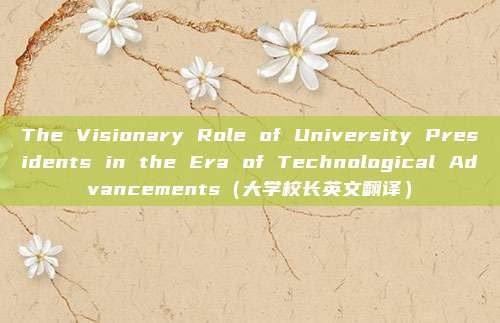The Visionary Role of University Presidents in the Era of Technological Advancements(大学校长英文翻译)
温馨提示:这篇文章已超过238天没有更新,请注意相关的内容是否还可用!
Content:
In an era where technology is revolutionizing the way education is delivered, the role of university presidents has become increasingly critical. As the custodians of academic excellence and innovation, these leaders are tasked with steering their institutions through tumultuous times, ensuring that students receive a top-notch education that prepares them for the challenges of the future. This article explores the pivotal role of university presidents and the strategies they employ to navigate the complexities of higher education.
Adapting to the Digital Landscape
One of the primary challenges faced by university presidents today is the rapid evolution of technology. A report by the EDUCAUSE Center for Analysis and Research (ECAR) suggests that technology adoption is a top priority for university leaders (EDUCAUSE, 2021). As such, presidents must be adept at embracing digital tools and platforms that enhance learning and administrative processes.

For instance, the University of Cambridge, under the leadership of its president, Dame Professor Lesley Yellowlees, has invested heavily in online learning resources and virtual classrooms to ensure that education continues uninterrupted despite physical challenges such as the COVID-19 pandemic (University of Cambridge, 2020). This proactive approach has not only maintained academic standards but has also paved the way for new modes of education that may endure beyond the crisis.
Fostering Innovation and Entrepreneurship
Another crucial aspect of a university president's role is to foster an environment of innovation and entrepreneurship. This involves not only supporting research endeavors but also ensuring that students are exposed to real-world problem-solving scenarios.
According to a survey by the Center for College Affordability and Productivity, 83% of college students believe that hands-on experience and the opportunity to create and innovate are essential components of their education (CCAP, 2022). To this end, university presidents must align their institutions with industry leaders and create opportunities for students to engage in research projects and internships that are relevant to the needs of the workforce.
An excellent example of this is the Massachusetts Institute of Technology (MIT), whose president, L. Rafael Reif, has emphasized the importance of innovation in education and research. MIT's approach to integrating practical experiences into the curriculum has made it a global leader in fostering entrepreneurial talent (MIT, 2021).
Enhancing Access and Equity
In a world where the demand for higher education is growing exponentially, university presidents also play a crucial role in ensuring access and equity. This includes advocating for underrepresented groups and implementing policies that make education more affordable.
The University of California, Berkeley, under the leadership of Chancellor Carol Christ, has made significant strides in promoting equity and inclusion. The institution's commitment to supporting diverse student populations and its extensive financial aid programs have helped democratize access to higher education (UC Berkeley, 2021).
Conclusion
The role of university presidents in the modern higher education landscape is multifaceted and demands a delicate balance of strategic vision, innovation, and social responsibility. As education continues to evolve in the face of technological advancements, these leaders must remain at the forefront, driving their institutions towards a future that is both equitable and innovative.
References:
- EDUCAUSE. (2021). 2021 ECAR Student Technology Survey: Key Findings. Retrieved from https://www.educause.edu
- University of Cambridge. (2020). Virtual Learning Environment (VLE). Retrieved from https://www.cam.ac.uk
- CCAP. (2022). Student Experience and Learning Outcomes: A National Survey of Undergraduates. Retrieved from https://www.centerforcollegeaffordability.org
- MIT. (2021). Innovation and Entrepreneurship at MIT. Retrieved from https://www.mit.edu
- UC Berkeley. (2021). Diversity, Equity, and Inclusion. Retrieved from https://www.berkeley.edu
网站文章、图片来源于网络,以不营利的目的分享经验知识,版权归原作者所有。如有侵权请联系删除!





还没有评论,来说两句吧...